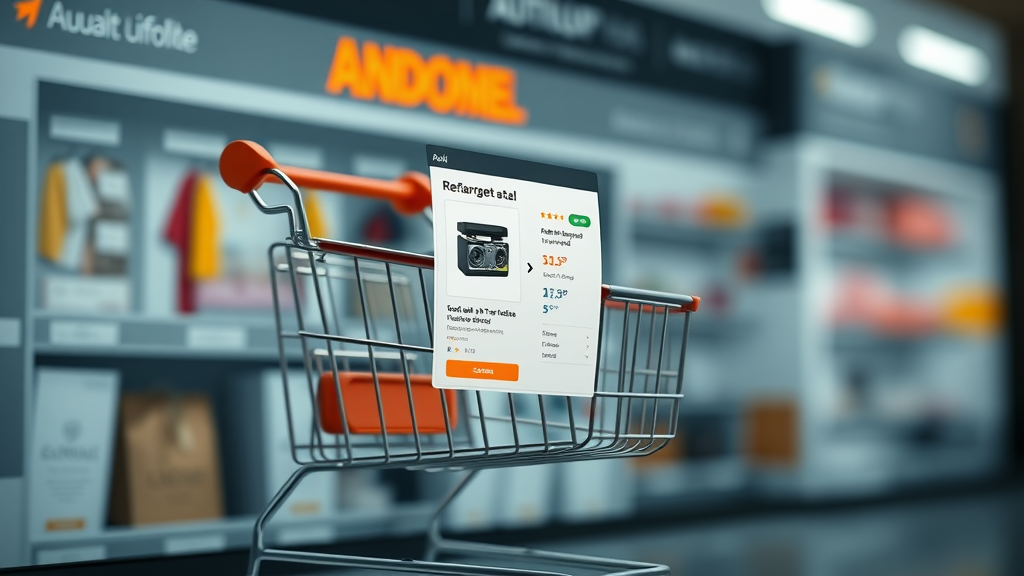Did you know that only 2% of website visitors convert on their first visit? That means a staggering 98% of your site visitors leave without taking action—unless you have a plan. Retargeting ads are the digital marketing secret weapon for reclaiming these missed opportunities and turning casual browsers into loyal, high-value customers. In this comprehensive guide, we’ll unravel how retargeting campaigns work, highlight expert strategies, and show you exactly how to build retargeting ads that convert, even in crowded markets.
Why Retargeting Ads Are Critical: Uncovering the Missed Opportunities in Your Retargeting Campaigns
"Only 2% of website visitors convert on their first visit. Retargeting ads aim to capture the remaining 98%."

- Explore the definition and value of retargeting ads
- Startling statistics on retargeting work and its impact
- Unconventional success stories from top brands
Retargeting ads are essential in today’s overloaded digital landscape. Many businesses invest heavily in acquisition, yet the majority of site visitors leave without converting—often forever. Retargeting campaigns focus on those users, presenting carefully targeted digital ads to reignite their interest after they've left your site. The numbers don’t lie: businesses using retargeting ads see conversion rates skyrocket, brand awareness rise, and the return on their marketing campaign spend increase dramatically. Retargeting work isn’t just about following people; it’s about reminding potential customers of what they are missing, and inviting them back when the time (and offer) is just right.
Whether you run an ecommerce store or manage lead generation for a service, the ability to reach out to site visitors who already know your brand offers a massive edge. Leading brands have leveraged retargeting campaigns to triple their ROI, reactivate lapsed customers, and dominate markets where competitors are still pouring budget into broad, unfocused digital ad strategies.
What You'll Discover About Retargeting Ads in This Guide
- Essentials of every retargeting campaign that truly converts
- The full spectrum of retargeting ads for social media, display ads, and email retargeting
- Advanced dynamic retargeting strategies, illustrated with real-life examples
- How to optimize retargeting work for higher ROI

| Retargeting Ads Aspect | Beginner Mistake | Pro Tip for Success |
|---|---|---|
| Audience Segmentation | Broad targeting | Granular segment creation |
| Creative Customization | Generic messaging | Personalized dynamic retargeting ads |
| Frequency Cap | Overexposure | Optimized impression limits |
| Platform Choice | Single channel adapts | Cross-channel retargeting strategy |
By the end, you’ll not only understand how retargeting ads help recapture and convert your audience—you’ll also walk away with a blueprint to create retargeting campaigns that outperform industry benchmarks.
What is Retargeting Ads? Demystifying the Retargeting Ad Essentials
The Core of a Retargeting Ad: How Retargeting Ads Work to Re-Engage Audiences
- Retargeting campaigns explained step-by-step
- Role of cookies and tracking pixels
- How display ads and social media platforms fit in

At their core, retargeting ads are a form of targeted digital advertising designed to re-engage potential customers who have previously interacted with your website or app. Here’s how it works: when someone visits your site, a retargeting pixel or tracking cookie is set on their browser. As they navigate away—perhaps to scroll social media or browse a news site—your ads are strategically displayed across their online journey, reminding them of what they left behind.
Most commonly, display ads are shown through networks like Google Display Network or Facebook’s suite of properties. These can be banner ads, text ads, or even dynamic retargeting units featuring specific products that a visitor viewed but didn't purchase. This coordinated effort ensures your brand stays relevant even when potential customers aren’t on your site, significantly increasing the chances they’ll return and complete their purchase.
Retargeting work leverages behavioral data for smarter marketing campaigns—using advanced audience segmentation to show the right message, to the right user, at the right time. Whether through social media ads, search, or email retargeting, the entire process revolves around creating a seamless, omnipresent reminder to help users take the final step and convert.
Why Retargeting Work: The Psychology Behind Retargeting Campaigns
- Consumer behavior and the conversion journey
- The multi-touch marketing campaign model
- Retargeting ad versus remarketing ads
The magic of retargeting work is rooted in human psychology. Most people rarely buy immediately—modern consumers need multiple “touches” before making a purchase or commitment. By showing retargeting ads to users who already visited your website , you’re nudging them just when they're most likely to reconsider. Studies prove users are far more inclined to click on a targeted ad they've seen before, especially when the message aligns with their specific interests or purchase history.
This fits perfectly into the multi-touch marketing campaign model. When you integrate retargeting campaigns with other digital marketing efforts, your brand benefits from repeated exposure and trust-building. In other words, a retargeting ad amplifies the impact of your other marketing initiatives and closes the conversion loop.
While “retargeting” and “remarketing” are sometimes used interchangeably, retargeting ads usually refer to ad placements on networks and social media, while remarketing tends to mean email follow-ups. Both approaches drive higher conversion rates by focusing on people who have already shown interest, rather than chasing cold leads.
The Science of Retargeting Ads: Types, Platforms, and Strategies
Types of Retargeting: Display Ads, Social Media, Email Retargeting, and More
- Display ads across search and site networks
- Facebook ad retargeting and other social media platforms
- Email retargeting and personalized outreach
- Dynamic retargeting to target people with tailored product suggestions

Retargeting ads come in a variety of flavors, making it essential to choose the best approach for your audience. Common types include classic display ads through networks like Google Ads, which appear on websites, news outlets, and even within apps. Social media retargeting is rapidly growing, with Facebook ad, Instagram, and LinkedIn offering granular targeting to reach users as they engage with content, friends, and interests.
Another powerhouse is email retargeting . This approach sends automated, highly personalized emails to users based on prior activity—think abandoned cart reminders or product recommendations—which makes the outreach feel like a direct follow-up. The most advanced campaigns rely on dynamic retargeting , where the messaging and creative update automatically based on the user’s recent interactions, such as the products they viewed or added to a shopping cart.
What unites all types of retargeting is a strategic focus on segmentation, personalization, and relevance. Rather than using generic text ad blasts, finely tuned campaigns target people based on their specific touchpoints—resulting in substantial lifts in engagement and ROI.
Choosing the Right Platform For Retargeting Ads and Retargeting Campaigns
- Comparing Google, Facebook ad, Instagram, and LinkedIn retargeting
- Multi-channel versus single-channel retargeting campaigns
- Integrating email retargeting with other retargeting ads
Not all platforms are created equal when it comes to launching high-performance retargeting campaigns. Google Ads offer vast reach on the Display Network, ideal for broad exposure and sophisticated audience matching. Facebook ad and Instagram excel at highly visual, interactive campaigns that mix seamlessly with newsfeed content, making them perfect for ecommerce and consumer brands.
Platforms like LinkedIn uniquely benefit B2B marketers—retargeting work can be focused on specific job titles or companies. Multi-channel retargeting, where you orchestrate campaigns across multiple platforms, amplifies your message and increases the odds of recapturing a lost site visitor. By also integrating email retargeting and syncing audiences, you ensure users see your brand across their entire online journey without oversaturating any single channel.
Ultimately, the right platform depends on where your target audience spends their time and how they engage with digital content. Testing multiple platforms—and combining their strengths in your retargeting ad strategy—is the key to unlocking consistent conversions.
Blueprint for a Winning Retargeting Campaign: Steps to High-Converting Retargeting Ads
Building Retargeting Audiences: Who to Target and Why
- Visitor segmentation: visited your website, product pages, and abandoned carts
- Lookalike audiences and targeting existing customers
- Lists for broad and granular retargeting work
The foundation of any effective retargeting campaign is smart audience construction. Successful campaigns move beyond simply targeting all users who visited your website—they use segmentation to create lists for different behaviors. For example, you might have one retargeting campaign focused on visitors who abandoned a shopping cart , and another for users who spent time on high-value product or service pages.
Savvy marketers extend their reach with lookalike audiences, which allow your campaigns to target people who exhibit similar traits and behaviors to your best customers or converters. These lists can be as broad or as granular as needed—enabling you to deliver hyper-relevant retargeting ads that match intent and readiness to buy, instead of overwhelming everyone with the same message.
By segmenting audiences based on behavior and value, you ensure that your retargeting work isn’t just efficient—it’s highly effective in recapturing both lost leads and engaging warm prospects.
Crafting Compelling Retargeting Ads That Resonate
- Best copy practices for display ads, social media, dynamic retargeting
- Visual strategies for impactful retargeting ad creative
- Split testing and ad variation

Writing a great retargeting ad starts with clarity, relevance, and urgency. Messaging should speak directly to a user’s intent—reminding them of the exact product, service, or offer they considered. Whether crafting a Facebook ad or a banner on the display network, calls-to-action like “Finish Your Purchase” or “Still Interested?” can prompt users to act.
Visuals matter just as much. Dynamic image retargeting that displays the user’s previously viewed item outperforms generic images every time. Use bold, on-brand colors, consistent fonts, and clear product or service visuals to boost recognition and trust. Don’t overlook the power of split testing different variants of your creative assets—test headlines, images, and offers to discover what drives the highest engagement and conversion rates in your retargeting campaigns.
Remember, personalization is the name of the game. The more you tailor your ads to the audience’s prior actions and interests, the more powerful your retargeting work becomes.
Setting Up an Effective Retargeting Campaign: Platform-Specific Steps
- Facebook ad retargeting setup walkthrough: Install the Facebook Pixel on your website, create custom audiences based on page visits, then build ad sets tailored for each segment—such as product page viewers or cart abandoners.
- Launching Google display ads retargeting campaigns: Add the Google Ads remarketing tag to your site, define specific audience lists (e.g., homepage visitors, high-intent buyers), and develop engaging display ads for each group.
- Advanced settings for frequency capping and ad exclusions: Prevent ad fatigue by limiting how often users see your retargeting ad each day, and always exclude recent purchasers to avoid wasted spend.
Each platform offers robust controls for target audience creation, ad creative, and campaign optimization—allowing you to tailor every stage to your business goals.
Examples of Retargeting Ads: Strategies That Drive Conversions
What is an Example of a Retargeting Ad? High-Performance Formats and Templates
- Carousel display ads on Facebook targeting people who visited your website
- Automated email retargeting sequences for abandoned cart recovery
- Cross-channel campaigns for maximum reach

Some of the most effective retargeting ads leverage rich media and personalized information. For example, a carousel Facebook ad can showcase multiple products a user browsed on your ecommerce store, with a direct link back to their shopping cart. Email retargeting works similarly—using automated sequences that remind users about items they're eyeing and offering special incentives to complete the sale.
Cross-channel retargeting campaigns take performance to the next level. By ensuring users are reminded across Google Ads, Facebook ad, and email, you maximize brand awareness and make it nearly impossible for potential customers to forget your offer.
These examples aren’t just about clever targeting—they’re about building a persistent, persuasive narrative that gently moves people down the marketing funnel, from initial curiosity to final sale.
Case Studies: Successful Retargeting Campaigns from Leading Brands
- Brand X: Tripling ROI with dynamic retargeting
- Brand Y: Social media retargeting for existing customer reactivation
- Brand Z: Display ads that convert cold audiences
"Retargeting ads helped us increase post-visit conversions by over 150%." – Digital Marketing Lead, Brand Z
Top brands are proof that well-orchestrated retargeting campaigns deliver results. Brand X implemented dynamic retargeting, customizing display ads based on browsing behavior—and saw ROI triple within 90 days. Brand Y reactivated thousands of lapsed, existing customers using Facebook ad retargeting and targeted offers, while Brand Z’s cross-channel campaigns converted cold audiences who otherwise slipped away.
Across industries, retargeting work consistently outperforms generic digital ad campaigns, ensuring that no valuable prospect goes untapped.
Optimizing Retargeting Ads: What Makes Retargeting Work for Every Campaign
How Effective Are Retargeting Ads? Measuring Success With Analytics
- Key metrics for evaluating retargeting campaign impact
- Conversion tracking setups
- ROI calculations versus other marketing campaign types

A successful retargeting campaign relies on careful measurement. The most critical metrics include conversion rate (the percentage of retargeted users who take action), cost per acquisition (CPA), post-click revenue, and return on ad spend (ROAS). Analytics dashboards—whether built into Google Ads, Facebook ad Manager, or third-party platforms—enable marketers to track every impression, click, and conversion.
Proper conversion tracking setups often involve combining cookies, retargeting pixels, and UTM parameters, ensuring you know exactly which retargeting ads drive value. Compared to typical prospecting campaigns aimed at cold audiences, retargeting often shows a higher conversion rate and lower CPA.
By regularly benchmarking results across all marketing campaign types, you can allocate budget where it’s most effective—amplifying the tactics that generate the strongest ROI while optimizing or pausing those that underperform.
Continuous Improvement: Tweaking and Scaling Retargeting Campaigns
- A/B testing display ads, email retargeting and social media content
- Lookalike expansion using retargeting data
- Automation tips for scaling retargeting campaigns
"There’s no such thing as a set-and-forget retargeting ad. The winners are always testing, always learning."
Never settle for yesterday’s results. High-performing marketers are always running A/B tests on creative, headlines, and offers across every ad type—including display ads , social media, and email retargeting. Even subtle tweaks can deliver outsized improvements in click-through rates and conversions.
As campaigns generate user data, expand successful segments into lookalike audiences or test different creative angles with automation tools for campaign scaling. Set up rules for frequency capping and exclusions to avoid overexposure, which can lead to ad fatigue.
Ultimately, the cycle of testing, learning, and iterating ensures your retargeting campaigns stay fresh, relevant, and profitable.
Unlocking Advanced Retargeting: Dynamic Retargeting, Sequencing, and Attribution
Harnessing Dynamic Retargeting and Sequenced Retargeting Ads
- How dynamic retargeting ads display individualized offers
- Sequencing retargeting ads for evolving user intent
- Real-world examples of retargeting ad sequencing

Dynamic retargeting takes personalization to the next level. Rather than showing the same generic text ad or banner to every user, dynamic creative pulls in actual product images and pricing relevant to what a user previously viewed. This individualized approach increases ad relevance—a key driver of conversions in any retargeting campaign .
Sequenced retargeting ads build on this idea by delivering a series of ads over time, each tailored to the user's stage in the journey. For example, users who visited your website but didn’t add to cart might first see a reminder ad, followed by a promo offer a few days later. This evolving cadence keeps your brand top-of-mind and adapts messaging based on buying signals.
Leading brands deploy sequenced and dynamic retargeting as their “always-on” digital marketing engine—one that automates much of the heavy lifting and drives conversions at scale.
Attribution and the Retargeting Campaign Funnel
- Understanding attribution models in marketing campaigns
- Cross-device retargeting and attribution best practices
- When to optimize or sunset retargeting campaigns
Measuring the true impact of retargeting ads depends on having the right attribution model. Many conversions are influenced by multiple touchpoints—a blog post, a Facebook ad, an email, and finally, a retargeting ad that closes the deal. Marketers use attribution models (first-click, last-click, linear, and position-based) to assign credit where it’s due.
Advanced retargeting work includes cross-device tracking—ensuring your message follows users from desktop to mobile and back again. Regular campaign analysis tells you which ads to double down on, and when it’s time to pivot or pause underperforming segments.
Proper attribution means you’ll always know how your retargeting campaigns contribute to the entire marketing campaign funnel—and how to optimize for even bigger wins.
People Also Ask About Retargeting Ads
What is retargeting ads?
- Retargeting ads are online advertisements shown to users who have previously interacted with your website or mobile app. They aim to bring back potential customers who didn't convert the first time by reminding them of your brand, products, or services. This is typically achieved using cookies, tracking pixels, and audience segmentation in retargeting campaigns.
What is an example of a retargeting ad?
- An example of a retargeting ad could be a dynamic Facebook ad displaying the specific products a visitor viewed but didn’t purchase, encouraging them to complete the transaction. Another example is a Google display ad reminding users of items left in their online shopping cart.

How effective are retargeting ads?
- Retargeting ads are proven to increase conversion rates and boost return on ad spend (ROAS). Statistics show users are 70% more likely to convert when retargeted with display or social media ads, making them a staple in digital marketing strategies.
What are remarketing ads?
- Remarketing ads are very similar to retargeting ads, often used interchangeably. However, remarketing typically refers to email strategies targeting previous website visitors, while retargeting is more broadly used for ads across web platforms and social media.
Can I run a retargeting ad for a new website?
- Yes, as soon as your website has traffic, you can begin building retargeting audiences using pixels from Facebook ad or Google display ads. Starting early helps establish data baselines for future retargeting campaigns.
Are retargeting ads expensive?
- Costs are typically lower per conversion compared to prospecting campaigns because retargeting work focuses ads on warm or high-intent audiences, increasing efficiency.
What is the difference between retargeting ads and prospecting ads?
- Prospecting ads acquire cold audiences who have never interacted with your brand, while retargeting ads focus on re-engaging visitors who have previously interacted, such as those who visited your website or engaged on social media.
What is dynamic retargeting?
- Dynamic retargeting automatically updates retargeting ad creative to showcase product or content based on the viewer’s past interactions, providing more relevant and effective reminders.
How do I measure the ROI of my retargeting ads?
- ROI is measured by comparing the revenue attributed to retargeting campaigns against the ad spend using analytics dashboards, tracking pixels, and attribution models.
Advanced Best Practices for Retargeting Campaigns That Drive Results
Segmentation: Target People Who Matter Most
- Focusing retargeting campaigns on valuable users: cart abandoners, past buyers, high-intent page viewers
- Exclusions: When NOT to show a retargeting ad
Prioritizing high-value segments in your retargeting campaigns yields the highest ROI. Focus on users with clear buying signals: those who added items to a shopping cart , made previous purchases, or spent significant time on high-intent product pages. Exclude those who recently converted or opted out to prevent wasted impressions and maintain a positive brand experience.
Advanced segmentation enables you to increase efficiency—showing just the right ad to users most likely to convert, while reducing irritation among those who have already taken action. In essence, smarter segmentation is the backbone of effective retargeting work.
Ad Creative Tips: Making Display Ads and Social Media Shine
- Personalization and dynamic retargeting best practices
- Calls-to-action that drive clicks
- Design differences for social media vs display ads

Standout creative is non-negotiable. Leverage dynamic creative to personalize visuals and copy for each segment. Calls-to-action should be direct (“Complete Your Order”, “See What’s New”), compelling, and visually distinctive. Remember, social media retargeting often rewards a conversational tone, lively imagery, and movement, while display ads may benefit from bolder graphics and clarity for users quickly scrolling through diverse web content.
Consistently A/B test variations to discover what best resonates with your target audience —and don’t shy away from applying winning learnings across channels.
Enhancing Email Retargeting and Integrating Retargeting Ads
- Email automation for cross-channel retargeting
- Best subject lines for email retargeting
- Synergy between retargeting ads, marketing campaigns, and email
Email retargeting remains one of the highest converting retargeting channels—particularly for abandoned cart recovery and personalized offers. Integrate automation workflows that trigger when users hit specific milestones (e.g., viewing, adding to cart, or partial checkout) and experiment with subject lines that spark curiosity (“Left Something Behind?” or “Your Favorites Are Waiting”).
Align messaging in email retargeting and digital ad retargeting to provide a unified brand journey—reinforcing trust and boosting the odds of winning back wavering prospects.
Expert Insights: Quotes on the Power of Retargeting Ads
"Retargeting campaigns are the backbone of any data-driven marketing strategy." – Industry Analyst
"It’s not just about one retargeting ad, but a complete retargeting campaign sequence that delivers true value to the user." – Paid Media Expert
Frequently Asked Questions About Retargeting Ads
Can I run a retargeting ad for a new website?
- Yes, as soon as your website has traffic, you can begin building retargeting audiences using pixels from Facebook ad or Google display ads. Starting early helps establish data baselines for future retargeting campaigns.
Are retargeting ads expensive?
- Costs are typically lower per conversion compared to prospecting campaigns because retargeting work focuses ads on warm or high-intent audiences, increasing efficiency.
What is the difference between retargeting ads and prospecting ads?
- Prospecting ads acquire cold audiences who have never interacted with your brand, while retargeting ads focus on re-engaging visitors who have previously interacted, such as those who visited your website or engaged on social media.
What is dynamic retargeting?
- Dynamic retargeting automatically updates retargeting ad creative to showcase product or content based on the viewer’s past interactions, providing more relevant and effective reminders.
How do I measure the ROI of my retargeting ads?
- ROI is measured by comparing the revenue attributed to retargeting campaigns against the ad spend using analytics dashboards, tracking pixels, and attribution models.
Key Takeaways for Launching Retargeting Ads That Convert
- Retargeting campaigns are essential for maximizing website and marketing campaign ROI
- Leveraging audience segmentation, creative personalization, and multi-channel strategies unlocks higher performance
- Continuous testing and optimization ensures sustained retargeting work success

"Missed out on conversions yesterday? Retargeting ads are your chance to win them back tomorrow."
Ready to Boost Your Results? Launch Your First Retargeting Campaign Today
- Start building custom audiences for your retargeting ads now
- Test dynamic retargeting creative for higher personal relevance
- Integrate retargeting campaigns into your larger marketing strategy for maximum impact
Take the first step: Explore your analytics, segment your audience, and set up your first retargeting campaign—see what conversions you’ve been missing!
Sources
- https://www.wordstream.com/retargeting-ads
- https://www.hubspot.com/marketing-statistics
- https://www.shopify.com/blog/retargeting-ads
- https://www.sproutsocial.com/insights/retargeting/
Retargeting ads are a powerful tool in digital marketing, allowing businesses to re-engage potential customers who have previously interacted with their website or content. By understanding and implementing effective retargeting strategies, you can significantly enhance your conversion rates and overall marketing ROI.
For a comprehensive understanding of retargeting, including its definition, types, and practical applications, consider exploring the article “ Retargeting: Definition, Types and How-tos .” This resource provides valuable insights into various retargeting campaigns and their optimal use cases.
Additionally, the guide “ What Is Retargeting? Strategy, Examples & Tools ” offers an in-depth look at different retargeting strategies, complete with real-world examples and tools to help you implement successful campaigns.
By leveraging these resources, you can gain a deeper understanding of retargeting ads and develop strategies that effectively convert your audience.
 Add Row
Add Row  Add
Add 




Write A Comment